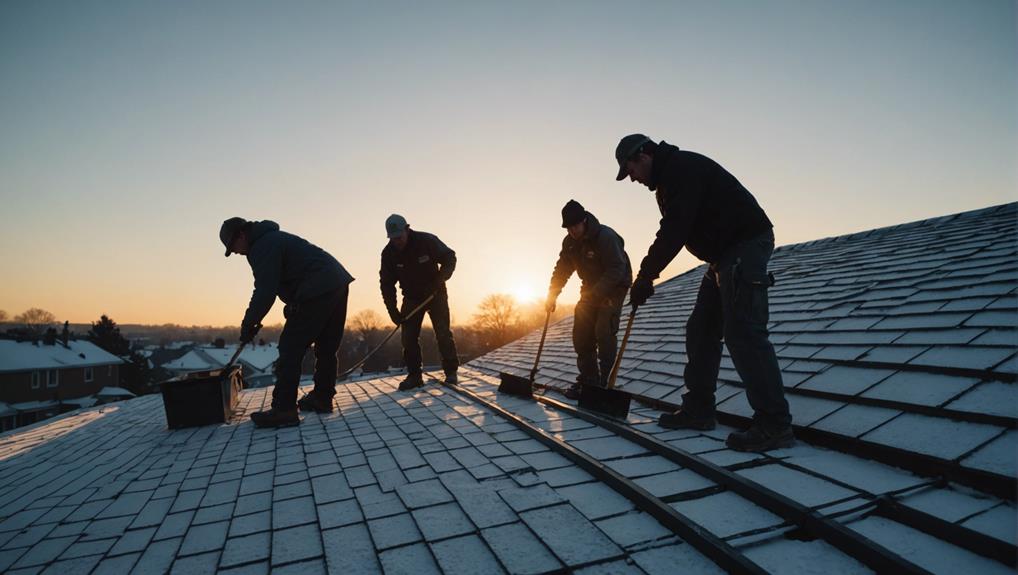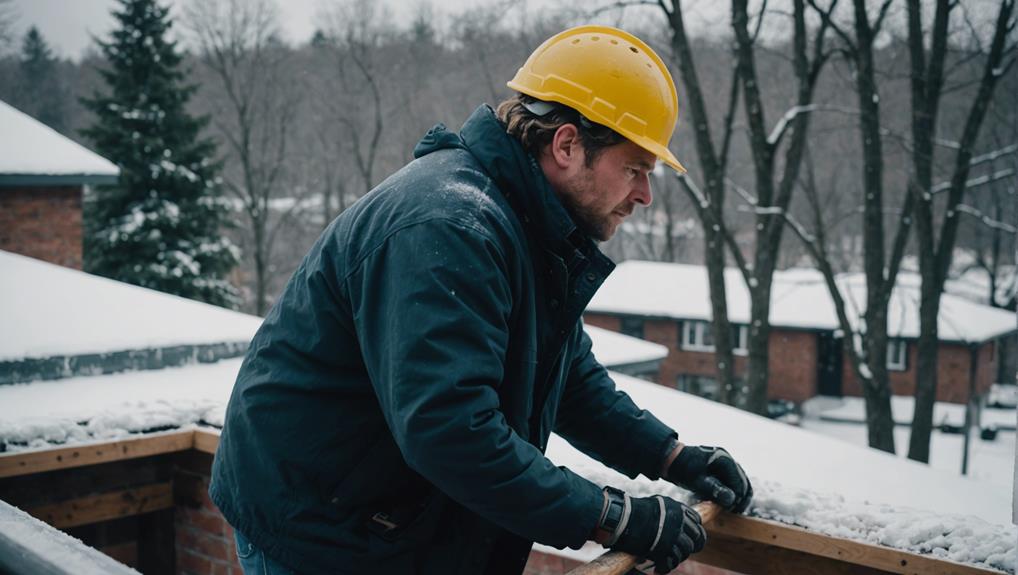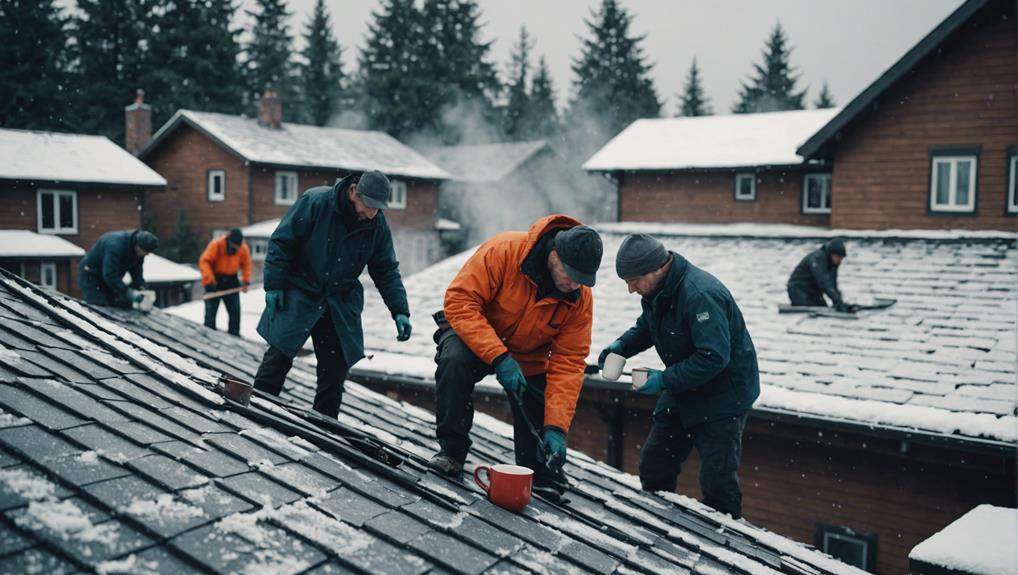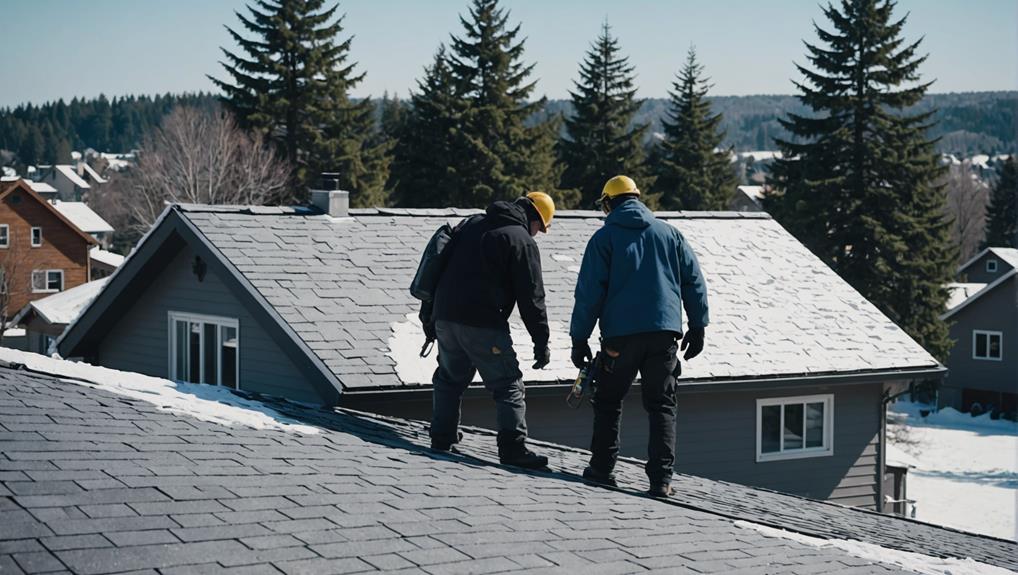If you've ever wondered about the importance of having your roof replaced during the winter months, there are some significant factors to take into account. While the idea may seem intimidating due to the cold weather, there are actually some benefits to undertaking this project in the colder seasons. However, before you make a decision, it's essential to weigh the pros and cons to guarantee the best outcome for your home.
Key Takeaways
- Cold temperatures aid sealant adhesion for better roof longevity.
- Experienced crews can mitigate challenges like brittle shingles and icy conditions.
- Winter installations ensure proper sealing techniques for durable roofs.
- Safety precautions, like fall protection, are crucial for winter roofing.
- Quality workmanship in winter offers lasting value despite potential challenges.
Benefits of Winter Roof Replacement
Starting a winter roof replacement project can offer you a multitude of benefits that extend beyond just cost savings.
When considering a new roof during the winter months, the cold temperatures actually work in your favor. The chilly weather helps the sealant on the shingles adhere better, creating a more secure bond and ensuring a durable roof for years to come.
Additionally, winter installations can prolong the lifespan of your roof by guaranteeing proper sealing and installation techniques are utilized.
Potential Challenges in Winter Roofing
When addressing a winter roof replacement project, it's important to be aware of the potential challenges that may arise due to the cold weather conditions. In winter roofing, cold temperatures can make asphalt shingles more brittle, affecting their adhesive properties and making them prone to damage during installation. Additionally, high wind speeds in winter can pose risks of wind damage, making it difficult for roofing crews to work efficiently and safely.
Roofing crews face challenges with malfunctioning tools and materials in cold weather, hindering the progress of roof replacement projects. Moreover, ice and snow hazards create slippery conditions, causing delays and risks for the workers. The freeze-thaw process during winter can also lead to flashing leaks, which are a common concern during roof replacements in cold weather. Professional roofing services are essential in addressing these challenges and ensuring that the roof replacement is done effectively despite the weather conditions.
Recommended Winter Roofing Practices

How can you guarantee a successful winter roof replacement project while maintaining peak sealant performance in cold temperatures?
When tackling roof replacements in winter weather, it's important to hire experienced roofing professionals who understand the nuances of working in cold weather. Opting for asphalt shingles that require manual sealing below 40°F ensures a secure installation. Trusting knowledgeable roofing crews who follow manufacturers' guidelines for sealants and roof installation is key to achieving a durable and weather-resistant roof.
Reputable roofing companies prioritize quality workmanship and adhere to recommended temperatures for best sealant performance, ensuring your roof can withstand the challenges of cold weather. Hand-sealing each shingle might take longer in low temperatures but guarantees a strong bond.
Impact of Cold Weather on Roofing
What challenges does cold weather present for roofing projects, particularly with asphalt shingles?
Cold weather poses several challenges for roofing projects, especially when working with asphalt shingles. Below 40°F, asphalt shingles may struggle to seal correctly, requiring manual sealing to make sure they adhere properly. Additionally, the cold temperatures can cause the shingles to become brittle and susceptible to cracking during installation, impacting their structural integrity.
Unlike asphalt shingles, metal and slate roofs are less affected by cold weather conditions. The ideal temperature range for installing asphalt shingles is between 40-85°F for best performance. In cold weather, careful handling of the shingles during cutting, nailing, and walking on the roof is essential to prevent damages. Understanding the effects of winter temperatures on roofing materials like asphalt shingles is important for a successful roof replacement project during colder months.
Winter Roofing Safety Tips

In order to guarantee the safety of roofing crews during winter installations, utilizing fall protection equipment is essential to prevent accidents on slippery roofs. Winter roofing safety tips are important for crew safety.
During winter installations, the roofing crew must take precautions to safeguard their safety. Work may need to be postponed in case of heavy snow or ice to protect the crew from hazards like frost, ice, and slippery conditions. Working on roofs during winter requires extra care and attention.
Good judgment is necessary when working in such conditions to maintain roof safety and crew well-being. Safety measures play an important role in protecting the crew from potential accidents. By following safety protocols and being mindful of the challenges posed by winter conditions, the roofing crew can carry out their work effectively while prioritizing safety above all else.
Factors to Consider for Winter Roof Replacement
When contemplating winter roof replacement, it is crucial to assess the temperature conditions to guarantee proper sealing of asphalt shingles. Cold temperatures below 40°F may impede the adhesive properties of asphalt shingles, necessitating manual sealing to make sure a secure bond. Experienced roofing crews have the expertise to hand-seal shingles effectively even in winter, preventing potential issues like leaks or wind damage. Reputable roofing companies adhere to manufacturers' guidelines for sealants, ensuring quality work regardless of the season. While lower prices for winter roof replacement may be enticing, they do not always reflect the longevity of the work performed. Opting for quality roofing jobs in winter can offer lasting value and protection for your home, with properly sealed asphalt shingles lasting for decades.
| Factors to Consider for Winter Roof Replacement | |
|---|---|
| Asphalt shingles may not seal below 40°F | Cold temperatures |
| Experienced crews can hand-seal shingles | Hand-seal shingles |
| Reputable companies follow manufacturers' guidelines | Reputable roofing companies |
| Lower prices may not indicate quality longevity | Lower prices |
| Quality work in winter can provide lasting value | Quality work longevity |
Winter Roofing Considerations

Consider the unique challenges and advantages that come with winter roof replacements to guarantee a successful and durable outcome for your home.
- Asphalt Shingles and Cold Weather: Asphalt shingles may not seal properly below 40°F, necessitating hand-sealing to make sure a secure bond in winter conditions.
- Importance of Experienced Crews: Winter roofing demands experienced crews to follow manufacturers' guidelines meticulously, ensuring proper installation techniques even in cold weather.
- Quality Work Over Lower Prices: While winter often brings lower prices for roof replacements, prioritizing reputable roofing companies offering high-quality work is essential. Remember, the cost savings shouldn't compromise the quality and longevity of the roofing project.
Frequently Asked Questions
Is It Okay to Replace a Roof in Winter?
Replacing your roof in winter is achievable with proper precautions. Winter installation necessitates attention to roofing materials, snow removal, and ice dams. Guarantee thermal insulation, contractor availability, roofing warranties, safety, and moisture barriers are addressed for successful results.
What Time of Year Is Best to Replace a Roof?
In the roofing domain, timing plays a pivotal role. Summer installations sizzle with efficiency, spring timing blooms with promise, fall considerations pave the way. Weather impacts, roofing myths unravel, seasonal benefits shine. Cold weather challenges, warm weather soothes, roofing materials adapt.
What Is the Best Weather to Replace a Roof?
In summer, roofing projects thrive with warmer temperatures ideal for sealant activation and efficient installations. During winter, snow removal, material complications, and potential work delays are factors worth taking into account. Consult professional roofing companies for guidance.
What Temperature Is Too Cold to Put on a New Roof?
In cold temperatures, roofing materials like asphalt shingles may not seal correctly, necessitating manual sealing by roofing contractors. This can lead to insulation concerns, snow removal difficulties, and increased winter hazards. Guarantee proper installation to avoid issues.
Conclusion
To sum up, having your roof replaced in the winter can be a beneficial decision if done correctly.
Did you know that studies have shown that roofs installed in colder temperatures actually have a longer lifespan than those installed in warmer weather?
By following recommended practices, ensuring quality workmanship, and prioritizing safety, you can enjoy a durable roof that provides lasting value for years to come.
Trust experienced professionals to handle your winter roofing needs effectively.



